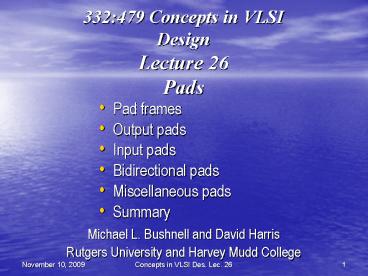332:479 Concepts in VLSI Design Lecture 26 Pads PowerPoint PPT Presentation
1 / 31
Title: 332:479 Concepts in VLSI Design Lecture 26 Pads
1
332479 Concepts in VLSIDesignLecture 26Pads
- Pad frames
- Output pads
- Input pads
- Bidirectional pads
- Miscellaneous pads
- Summary
- Michael L. Bushnell and David Harris
- Rutgers University and Harvey Mudd College
2
Material from Principles of CMOS VLSI Design By
Neil E. Weste and Kamran Eshraghian
3
Input/Output Structures
- Requires the most circuit design expertise and
detailed process knowledge - Pad size 100 to 150 mm2
- Pad spacing minimum pitch at which bonding
machines can operate 150 to 200 mm
4
Interdigitated (a), Core-limited (b) or
Pad-limited (c) Pads
5
Bump Pad
- Can be put anywhere on chip
- Plate pads with solder bumps
- Invert chip reflow bond to substrate
- Invented by IBM
- No pad connection failure EVER in IBM equipment
6
Pad Design
- Use multiple power ground pads to reduce noise
- Place VSS as outermost track
7
Pad Design
8
Example Pad Frame
- VDD / VSS Crossover
9
Input / Output
- Input/Output System functions
- Communicate between chip and external world
- Drive large capacitance off chip
- Operate at compatible voltage levels
- Provide adequate bandwidth
- Limit slew rates to control di/dt noise
- Protect chip against electrostatic discharge
- Use small number of pins (low cost)
10
I/O Pad Design
- Pad types
- VDD / GND
- Output
- Input
- Bidirectional
- Analog
11
Output Pads
- Drive large off-chip loads (2 50 pF)
- With suitable rise/fall times
- Requires chain of successively larger buffers
- Guard rings to protect against latchup
- Noise below GND injects charge into substrate
- Large nMOS output transistor
- p inner guard ring
- n outer guard ring
- In n-well
12
Input Pads
- Level conversion
- Higher or lower off-chip V
- May need thick oxide gates
- Noise filtering
- Schmitt trigger
- Hysteresis changes VIH, VIL
- Protection against electrostatic discharge
13
ESD Protection
- Static electricity builds up on your body
- Shock delivered to a chip can fry thin gates
- Must dissipate this energy in protection circuits
before it reaches the gates - ESD protection circuits
- Current limiting resistor
- Diode clamps
- ESD testing
- Human body model
- Views human as charged capacitor
14
Bidirectional Pads
- Combine input and output pad
- Need tristate driver on output
- Use enable signal to set direction
- Optimized tristate avoids huge series transistors
15
Analog Pads
- Pass analog voltages directly in or out of chip
- No buffering
- Protection circuits must not distort voltages
16
MOSIS I/O Pad
- 1.6 mm two-metal process
- Protection resistors
- Protection diodes
- Guard rings
- Field oxide clamps
17
Output Pad Design Constraints
- Latchup most apt to happen in pads
- Separate n and p transistors
- Use guard rings tied to supply
- Use double guard rings on I/O transistors
- Surround n transistor with VSS p ring
- Surround p transistor with VDD n ring
- Make rings continuous in diffusion and strapped
with metal - Use dummy collectors between I/O transistors and
internal circuitry - p connections to VSS
- n (in n-well) connections to VDD
18
More Pad Design Constraints
- Connect I/O transistors to dirty VSS VDD supply
signals - Single point connect to dirty VSS VDD
- All VSS / VDD connections must be ohmic in
metal - Make I/O transistors from parallel smaller
transistors - CMOS driver transistors are usually capable of
sinking 1.6 mA for a standard TTL load with VOL lt
0.4 V
19
Input Pads
- CMOS gate oxide punctures breaks down at 40 to
100 V - Use combination of resistance Zener diode
clamps to prevent this voltage from building on
gates - Typical circuit
- R limits diode peak current
- 200 W R 3 kW
- Use a tub resistor p diffusion in an n-well
process - Clamping diodes n in substrate and p in n-well
- Diodes need double guard rings
20
Input Pads
21
Input Pad Layout
22
n-Well Process Pads
- Can use all n-device I/O circuitry
- n diffused protection resistors
- n punchthrough devices
- Closely spaced source drain diffusion but no
gate - Avalanches at 50 V
- Input buffer longer than normal gates to
improve breakdown behavior - Add enough stages to amplify to drive internal
load
23
TTL to CMOS Level Conversion
- When reading TTL inputs into CMOS chip
- Set switching of I/P inverter to
- VOL VOH 0.4 2.4 1.4 V
- 2 2
- Change inverter b ratio
- Use on-chip p transistor tied to VDD (with
grounded gate) to pull pad input up to VDD when
it is high
24
Clock Buffer Design
- Single driver
- Four-sided approach
25
Down-the-Center Approach
- 10 inch long, O/P p transistor for clock driver
(serpentine)
26
Tri-State and Bidirectional Pad
27
Bidirectional Pad
28
Miscellaneous Pads
- With extra p or n transistor for pull-up or
pull-down - With latches or registers
- Gives chip low setup hold times
- Pad does not have to drive the input into the
chip to internal storage - Instead latch signal at pad, drive internal
chip circuits from latch
29
Pad Interference
- Fast-rising chip outputs generate UHF frequencies
interfere with radios, cellular telephones TV - Control by reducing high-order harmonics
- Controlled slew-rate pads
- Reduce I/O logic swing to reduce harmonics
30
CMOS Schmitt Trigger Pad
- Use hysteresis to get a clean edge from a slowly
varying input
31
Summary
- Pad frames
- Output pads
- Input pads
- Bidirectional pads
- Miscellaneous pads

